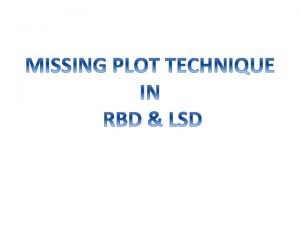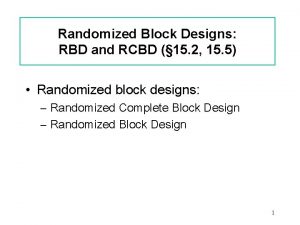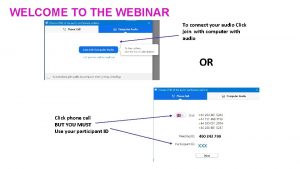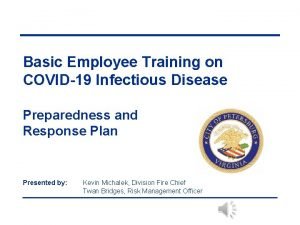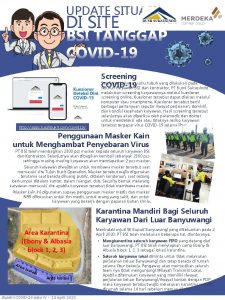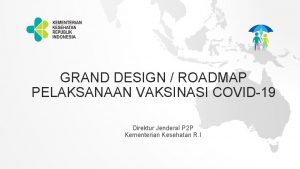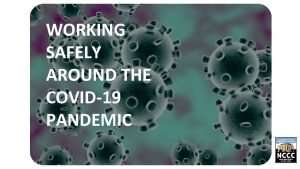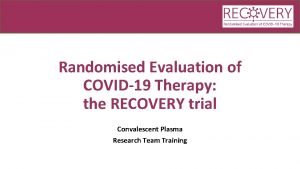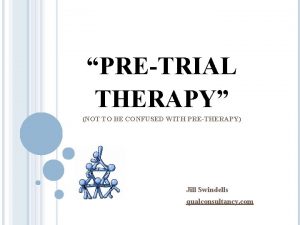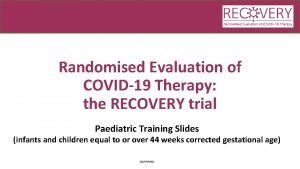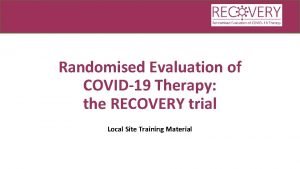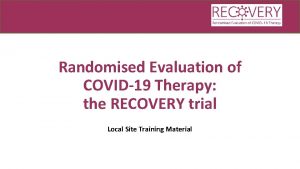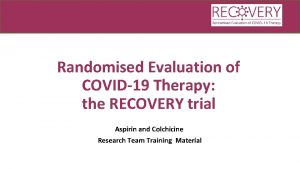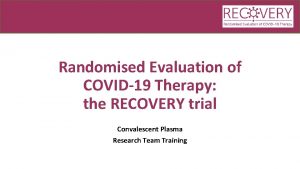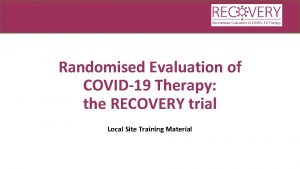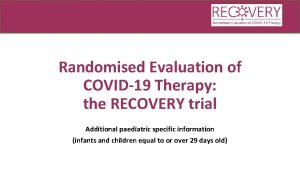Randomised Evaluation of COVID19 Therapy the RECOVERY trial











- Slides: 11

Randomised Evaluation of COVID-19 Therapy: the RECOVERY trial Local Site Training Material

Background • A novel coronavirus-induced disease was identified in Wuhan, China (COVID-19) • In January 2020 the Chinese CDC identified the causal agent as a new betacoronavirus (SARS coronavirus 2 or SARS-Co. V-2) • Symptoms vary from none to severe pneumonia in a minority • It is estimated that in the UK 50 million people may be infected, of whom 5% may need admission and of these 30% might need level 3 (ICU) care • The progression from prodrome to severe disease takes 1 -2 weeks, offering a therapeutic window

Previous results from RECOVERY • RECOVERY has already demonstrated that: • Neither hydroxychloroquine nor lopinavir-ritonavir reduce the risk of death • Dexamethasone reduces the risk of death among patients receiving oxygen or ventilation at baseline • The trial continues to investigate three other treatments in adults: • Azithromycin • Convalescent plasma • Tocilizumab (among sicker patients) • If you are involved in treatment of children, please watch the separate training video

Eligibility and outcomes • Eligibility criteria: 1. Hospitalised 2. Proven or suspected SARS-Co. V-2 infection 3. No medical history that might, in the opinion of the attending clinician, put the patient at significant risk if he/she were to participate in the trial • Outcomes: 1. All-cause mortality by 28 days after randomisation 2. Duration of hospitalisation; need for mechanical ventilation or death 3. Need for and duration of ventilation; renal replacement therapy, cardiac arrhythmias

SOC = Standard Of Care CP = Convalescent Plasma AZM = Azithromycin R = Randomisation Current protocol SOC - CP Tocilizumab R R 2 AZM + CP CP AZM - CP vs No CP No additional treatment OUTCOMES ELIGIBLE PATIENTS SOC + CP

Study treatments: Azithromycin • Commonly used antibiotic (“macrolide”) with antiviral and immunomodulatory properties • Contraindications: long QT syndrome, allergy to macrolide antibiotics • Side-effects: QT interval prolongation, interaction with other drugs (ciclosporin, digoxin)

Convalescent plasma • Please watch separate training video on convalescent plasma if your site is participating in this part of RECOVERY • Purpose is to test whether giving anti-SARS-Co. V-2 antibodies (in the plasma of people who have recovered from the infection) can aid recovery in patients hospitalised with COVID-19

Randomisation • If a study treatment is contraindicated in a given patient, then they can still be randomised • Randomisation will allocate them to one of the other treatments • Randomisation is ‘simple’ (i. e. no stratification or minimisation) • Randomisation ratio is 2 (standard care): 1: 1: 1

Study treatments: Tocilizumab • Humanized monoclonal antibody against IL-6 receptor • Licensed for treatment in: • Rheumatoid arthritis • Cytokine release syndrome (CRS) after CAR-T cell therapy (new treatment for haematological malignancy) • Side effects: Other infections

Second randomisation: eligibility • Eligibility criteria: • Receiving oxygen or oxygen saturations <92% on air • CRP ≥ 75 mg/L • No medical history that might, in the opinion of the attending clinician, put the patient at significant risk if s/he were to participate in this aspect of the RECOVERY trial • e. g. clear evidence of secondary bacterial infection causing deterioration

Summary • While COVID-19 is a mild disease in the majority, a significant minority require hospitalisation and face significant risks of morbidity and mortality • RECOVERY is currently testing azithromycin, convalescent plasma and tocilizumab to assess their effects on major morbidity and mortality • Other arms may be added to the ‘platform’ in the future
 Block design example
Block design example Randomised block design
Randomised block design Covid19 athome rapid what know
Covid19 athome rapid what know What do if test positive covid19
What do if test positive covid19 Http//apps.tujuhbukit.com/covid19
Http//apps.tujuhbukit.com/covid19 Vaksin covid19
Vaksin covid19 Do if you covid19
Do if you covid19 Recovery trial training
Recovery trial training Pre trial therapy training
Pre trial therapy training Psychoanalytic therapy is to as humanistic therapy is to
Psychoanalytic therapy is to as humanistic therapy is to Bioness bits cost
Bioness bits cost Humanistic therapies aim to boost
Humanistic therapies aim to boost
